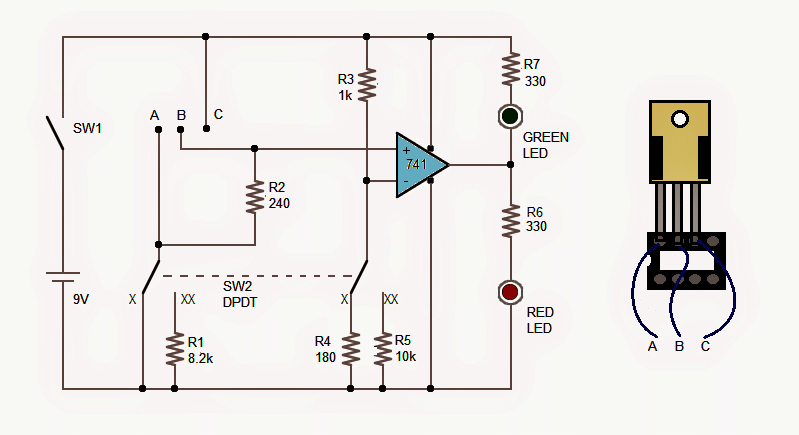Here is simple but handy testing circuit for LM317 adjustable voltage regulator IC. I am sure it can be used to test other similar ICs like LM117, LM158, LM358 etc.
The circuit is pretty straightforward. The circuit is based on normal configuration of adjustable voltage regulator.
How it Works
For details follow https://www.homemade-circuits.com/2011/12/how-to-build-simplest-variable-power.html
A DPDT switch is used to connect the ADJ pin of the IC to either ground or to the resistor R1. When connected to ground, the output should be at the lowest level around 1.2V and when connected to R1 the output should be the maximum level (around 7.5V for 9V input). Next, LM741 is used to compare the output with a preset voltage level.
When the DPDT switch is in X position the ADJ pin is connected to ground and the (-)ve input of 741 is connected to R4.
The potential divider R3+R4 gives about 1.37V at (-)ve input of 741 which is compared with the output from the Voltage Regulator IC.
In this case it should be about 1.2V which less than 1.37V hence the output of 741 remains low and the green LED glows. If for some reason the output from the voltage regulator IC is more than 1.37V the output of 741 goes high and the red LED lights up, indicating malfunction of the v/reg IC.
When the DPDT switch is in XX position the ADJ pin is connected to R1 and the (-)ve input of 741 is connected to R5. The potential divider R3+R5 gives about 8.1V at (-)ve input of 741 which is compared with the output from the Voltage Regulator IC.
In this case it is should be about 7.5V which less than 8.1V hence the output of 741 remains low and the green LED glows. If for some reason the output from the voltage regulator IC is more than 8.1V the output of 741 goes high and the red LED lights up, indicating malfunction of the v/reg IC.
If none of the LEDs glows, it indicates that input pin and ADJ pin of the voltage regulator IC is short because the +9V are connected to ground via ADJ pin.
An 8-pin IC base or simply a 3-pin female connector may be used to hold the v/reg. IC for testing.
Designed, Written and Submitted by: Abu-Hafss


Hi sir, I guess there is a mistyping in the value of R1, instead of 8.2k, the value has to be 1.2k.
According with formula from LM317 datasheet:
Vout = 1.25V x (1 + R1/R2) (your diagram resistors indexes)
For 7.5V and R2 = 240, a ratio 5:1 for R1 regarding of R2 value is ok. So I think the right value for R1 is 1.2k.
Thanks for diagram idea and best regards!
Thank you Doru,
You are absolutely correct, the value of R1 should be 1.2K for the IC to generate 7.5V
Hi, my friend, Swagatam!!!
Let me speak on this issue.
I think that the main disadvantage of this circuit is that you will not be able to check the IC for the peak current, and this is the most important thing. We all know that according to the datasheet, the LM317 passes up to 1.5 amperes, but modern Chinese fakes give out no more than 300 milliamps.
Agree that this is the main indicator of the quality of the IC LM317.
I have already encountered this problem, when out of 10 IC’s only 2 were working normally.
Unfortunately, this circuit becomes practically useless for testing LM317, if only for an internal break.
It is possible that this will give you an idea of how to make a full-fledged tester for these IC’s.
This is my personal opinion, which may not coincide with the public.
Thank you Jorge, for your valuable feedback.
You may be correct, however an easy way to confirm the current is by attaching a 2 amp 12V lamp at the output. If the lamp illuminates brightly will confirm the 1.5 amp output from the IC.
Hello,
Very clear and simple to understand tuto.
Many thanks.
Where to buy the PCB for this LM317 tester?
Best regards.
Pierre Au,
Thank you, sorry we don’t sell PCBs, you will have get it from a designer.
Thousand thanks for your kind answer.
Best regards.
Pierre